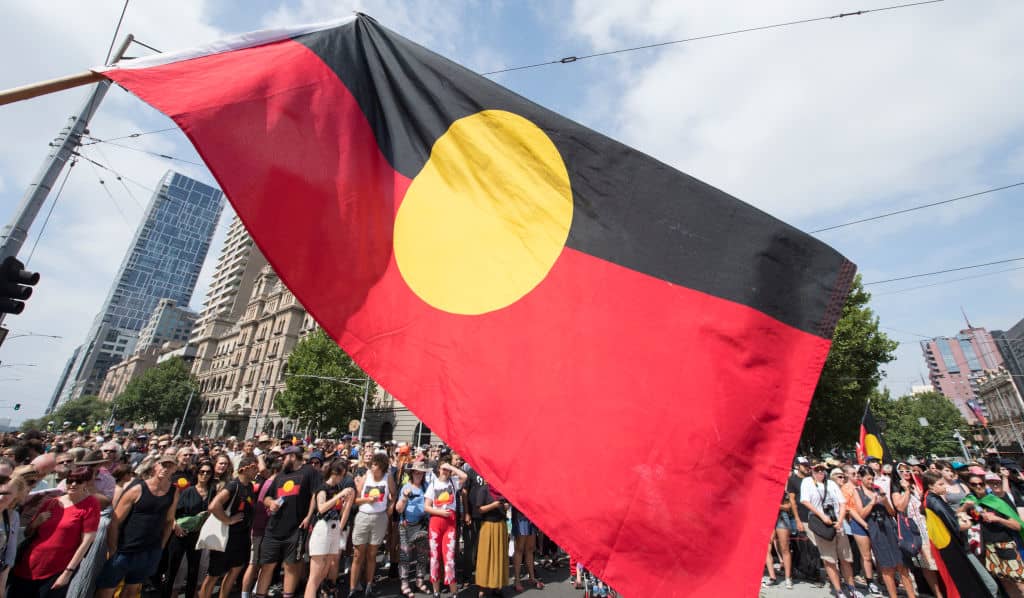The Aboriginal flag has finally been made free for public use after the Federal Government secured a deal with its copyright owners to buy the rights.
It’s a historic moment that will now see the iconic symbol of Aboriginal Australians flown freely and used widely across all manner of media, clothing, and designs.
After negotiations, Indigenous Affairs Minister Ken Wyatt said that the flag now belongs to all Australians.
“Over the last 50 years we made Harold Thomas’ artwork our own — we marched under the Aboriginal Flag, stood behind it, and flew it high as a point of pride,” Wyatt said in a statement.
“Now that the Commonwealth holds the copyright, it belongs to everyone, and no one can take it away.”
Prime Minister Scott Morrison has said that the flag would be managed in a similar way to the national Australian national flag, meaning it can be used freely but must be done so in a “respectful and dignified way”.
“All Australians can now put the Aboriginal Flag on apparel such as sports jerseys and shirts, it can be painted on sports grounds, included on websites, in paintings and other artworks, used digitally and in any other medium without having to ask for permission or pay a fee,” Morrison said.
“We’ve freed the Aboriginal Flag for Australians.”
Why Wasn’t The Aboriginal Flag Free in the First Place?
Campaigners have, for a long time, been arguing that the Aboriginal flag needs to hold the same status as the national flag. Brands like Clothing the Gaps have frequently sold popular t-shirt’s with the slogan ‘free the flag’ as its use in public and in particular private commercial senses has been impeded over the past few years.
View this post on Instagram
The Aboriginal Flag was first created by Harold Thomas, an Indigenous Luritja artist from Darwin in 1971. The red half of the flag represents the red earth of Australia and the red ochre used in traditional ceremonies, symbolising Indigenous connection to the land. The black half represents Indigenous people while the yellow circle in the middle represents the Sun as a life-giving, protecting force.
The flag was flown often by Indigenous people as a symbol of strength and pride, notably at the Aboriginal Tent Embassy in Canberra and by Olympic legend Cathy Freeman after her 200 and 400-metre sprint at the Sydney 2000 Olympics.
The flag only achieved official national recognition, along with the Torres Strait Flag, in 1995.
Thomas was awarded copyright ownership of the flag after a legal dispute in 1997, giving his company exclusive rights for the manufacture and marketing of the flag as well as products using the flag. In 2018, he granted WAM Clothing an exclusive licence for the use of the flag on clothing. Both the owners of the business are non-Indigenous white Australians who passed a portion of sales to Thomas.
They proved to be rather litigious, threatening legal action against certain Indigenous businesses for their use of the flag on clothing. They also sent notices to the NRL and AFL, demanding they stop using the flag on jerseys without paying compensation. In 2020, the AFL decided they wouldn’t continue to use the flag.
This prompted Aboriginal senator and athlete Nova Peris to back the ‘free the flag’ campaign, writing to the Governor-General to request WAM be stripped of copyright ownership.
A parliamentary committee investigating the use of the flag in 2020 found that WAM Clothing used a “heavy-handed (yet entirely legal) approach to enforcing its rights.”
Since 2019, the Australian government has been involved in a legal dispute with Thomas and WAM clothing over the copyright of the flag, finally reaching a settlement last night.
The Federal Government paid $20 million to secure the ownership of the flag, with Thomas retaining moral rights and a portion of the royalties for its use. Those funds will be donated to support NAIDOC Week while a $100,000 annual scholarship programme will be established in Thomas’ name to support Indigenous students.
Thomas has said that he hopes Australians would use the flag with respect and pride.
“I hope that this arrangement provides comfort to all Aboriginal people and Australians to use the Flag, unaltered, proudly and without restriction.”
“I am grateful that my art is appreciated by so many, and that it has come to represent something so powerful to so many.”
In typical 2022 fashion, Thomas has also minted an NFT of the flag to commemorate its 50th anniversary. He said that he will hold the NFT “on behalf of Indigenous communities.”
Read more stories from The Latch and subscribe to our email newsletter.







